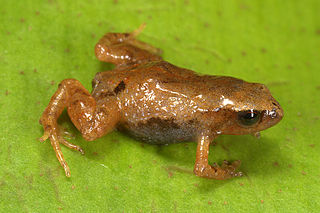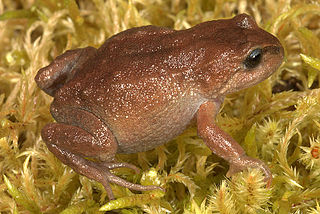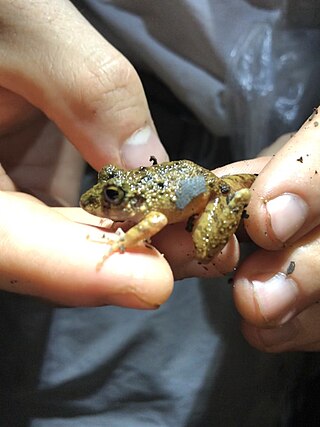
Oreobates is a genus of frogs in the family Strabomantidae. Most species were formerly in the genus Ischnocnema, but were moved to this revalidated genus following a 2006 revision. Its sister taxon is Lynchius.

Yunganastes bisignatus is a species of frog in the family Strabomantidae. It is endemic to the La Paz Department, Bolivia, and known from between the Inquisivi and Nor Yungas Provinces. It has been considered synonym of Pristimantis fenestratus but is now treated as valid species.
Yunganastes fraudator is a species of frog in the family Strabomantidae. It is endemic to Bolivia and found in the Cochabamba Department to the border with the Santa Cruz Department. It is sometimes known as Cochamba robber frog. Its specific name fraudator means "cheat" or "deceiver" and refers to its resemblance with Gastrotheca marsupiata.
Oreobates zongoensis is a species of frog in the family Strabomantidae. It is endemic to Bolivia from Zongo Valley, in Pedro Domingo Murillo Province.
Oreobates choristolemma is a species of frog in the family Strabomantidae. It is endemic to Bolivia where it is known from its type locality, Serranía de Bella Vista in the Caranavi Province as well as from Sud Yungas Province and from Chapare Province in the Cochabamba Department.

Oreobates quixensis, also known as the common big-headed frog, is a species of frog in the family Strabomantidae. It is found in the upper Amazon Basin in Bolivia, western Brazil, Colombia, Ecuador, and Peru. It is a very common terrestrial frog of primary and secondary tropical moist forest, also to be found in clearings, open areas and banana groves.
Ischnocnema sanctaecrucis is a species of frog in the family Strabomantidae. It is endemic to Bolivia where it is known from the Santa Cruz and Cochabamba Departments. It is an uncommon, terrestrial frog inhabiting the Yungas forest ; it tolerates disturbed habitats. It has been found under rocks; males have been observed perching on small secondary vegetation. It is not considered threatened by the IUCN. Its range includes the Carrasco and Amboró National Parks.
Oreobates saxatilis, also known as Tarapoto big-headed frog, is a species of frog in the family Strabomantidae. It is endemic to Peru and known from near its type locality near Tarapoto as well as from the Río Tambo District in the Satipo Province, Panguana in the Puerto Inca Province, and Río Kimbiri in the La Convención Province.
Lynchius simmonsi, also known as Simmons' big-headed frog, is a frog species in the family Strabomantidae. It is endemic to southern Ecuador where it is known from the type locality in the Cordillera del Cóndor, Morona-Santiago Province as well as from the adjacent Zamora-Chinchipe Province. Its natural habitat is subtropical old-growth forest. The type series was collected by day on the forest floor. The area was mined during the Cenepa War in 1995, and has consequently seen little human activity, although this may change through a proposed road.

Lynchius flavomaculatus, also known as the yellow-spotted Andes frog, is a species of frog in the family Strabomantidae. It is found in the Andes of southern Ecuador and northern Peru.
Lynchius parkeri, also known as Parker's Andes frog, is a species of frog in the family Strabomantidae. It is found in northern Peru and southern Ecuador. The specific name parkeri honors Hampton Wildman Parker, English zoologist and herpetologist.
Oreobates pereger, also known as the Ayacucho Andes frog, is a species of frog in the family Strabomantidae. It is endemic to Peru where it is known from the eastern slopes of the Cordillera Oriental and Cordillera Vilcabamba mountain ranges.

The Strabomantidae are a family of frogs native to South America. These frogs lack a free-living larval stage and hatch directly into miniature "froglets". This family includes Pristimantis, the most speciose genus of any vertebrate.

Bryophryne is a genus of frogs in the family Strabomantidae. These frogs are endemic to south-eastern Peru in the Cusco Region, with an undescribed species from the Puno Region. Their range is separated from that of Phrynopus by the Apurímac River valley.
Phrynopus tribulosus is a species of frog in the family Strabomantidae. It is endemic to Peru and only known from its type locality near Oxapampa at 2,600 m (8,500 ft) asl, and from Santa Bárbara, in the Huancabamba District, Oxapampa, Pasco Region. It inhabits humid montane forests where individuals could be found deep within a mossy bank by day.
Oreobates ayacucho is a species of frogs in the family Strabomantidae. It is endemic to Peru and known from a few localities in the Ayacucho Region in the Peruvian Andes. The species is only known from 11 specimens.
Phrynopus miroslawae is a species of frog in the family Strabomantidae. It is endemic to Peru and only known from its type locality, Santa Bárbara, in the Huancabamba District, Oxapampa, Pasco Region. The species is only known from the holotype collected in 2007. The specific name miroslawae honors Miroslawa Jagielko from Poland, recognizing her "friendship and support of taxonomic research and nature conservation in Peru".

Psychrophrynella is a genus of frogs in the family Strabomantidae The genus is distributed on the Andes of southern Peru and Bolivia. One of the four species assessed by the International Union for Conservation of Nature (IUCN) is assessed as "Critically Endangered".

Psychrophrynella usurpator is a species of frogs in the family Strabomantidae. It is endemic to Peru and known from near Abra Acjanacu, a mountain pass in the Cordillera de Paucartambo, the easternmost Andean range towards the Amazonian lowlands, and from the high elevation grasslands of the Manu National Park. It is named usurpator because these frogs were previously misidentified as Noblella peruviana—in a sense, they had "usurped" the name of another frog species.

Oreobates amarakaeri, also known as Amarakaeri's big-headed frog is a species of frog in the family Strabomantidae, which is endemic to a small region of south-eastern Peru, in the Manú District, and parts of the Puno Region. The frog was first discovered near the Rio Nusinuscato and Rio Mabe rivers in the Andean foothills of the Amarakaeri Communal Reserve, which are tributaries of the Rio Araza. Since then the species has also been found at the Manú Learning Centre and near Bahuaja Sonene National Park, but weren't fully confirmed to be there until 2019 when four specimens were collected at those localities. At the Manú Learning Centre the frog is known to occur mainly in low disturbance and primary forest habitat, but can also be found near streams in more disturbed areas.







